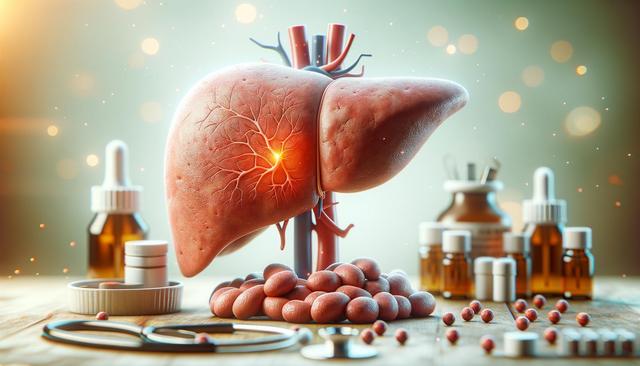Understanding Fatty Liver Disease and Its Hidden Symptoms
Fatty liver disease, also known as hepatic steatosis, occurs when fat builds up in the liver cells. This condition can be either alcoholic or non-alcoholic in origin, with the latter being more common in individuals who do not consume excessive alcohol. While many people with fatty liver disease may not experience obvious symptoms initially, the condition can progress and lead to a range of issues. One of the lesser-known signs is persistent skin itching, which can be both confusing and frustrating for those affected.
Itching, or pruritus, is not directly caused by fat accumulation in the liver but rather by the liver’s declining ability to process and eliminate bile effectively. As liver function deteriorates, bile salts can accumulate in the bloodstream and deposit into the skin, leading to chronic itching. Inflammation also plays a role, as the body’s immune response to liver damage can trigger sensations of itchiness. These subtle signs often go unnoticed until they significantly impact quality of life, making awareness crucial for early detection and management.
Why Does Fatty Liver Cause Itching?
While not every person with fatty liver disease will experience itching, it’s a symptom that can appear as the liver becomes more inflamed or damaged. The biochemical changes associated with impaired liver function can lead to systemic effects, including skin discomfort. Bile acids, which are normally excreted via the liver and gallbladder, may be retained in the body due to liver dysfunction. This retention irritates nerve endings in the skin, resulting in the sensation of itch.
Other contributing factors include:
- Inflammation of liver tissue, which may stimulate immune responses that affect the skin
- Oxidative stress caused by fat accumulation, which can disrupt normal skin function
- Alterations in hormone levels and metabolism associated with liver dysfunction
Itching associated with fatty liver often lacks a visible rash, which can make it difficult to diagnose. It may be felt more intensely at night or in specific areas such as the arms, legs, or back. Understanding the bodily processes behind this symptom can help patients seek appropriate medical guidance.
Other Hidden Signs of Fatty Liver Disease
In addition to itching, fatty liver disease can present with a variety of subtle signs. Many individuals are unaware they have the condition until it’s discovered during routine blood tests or imaging studies. However, being familiar with the lesser-known indicators can encourage earlier investigation and intervention.
Some common hidden signs include:
- Fatigue or unexplained tiredness
- Discomfort or fullness in the upper right abdomen
- Unexplained weight loss or difficulty maintaining weight
- Changes in skin color, such as yellowing (jaundice) or dark patches
- Swelling in the legs or abdomen (edema and ascites)
These signs, like itching, may not immediately suggest liver problems, but together they can paint a clearer picture of declining liver function. Monitoring these symptoms and discussing them with a healthcare provider can facilitate timely diagnosis and treatment.
Managing Itching and Liver Inflammation
Addressing itching associated with fatty liver disease involves both symptom relief and tackling the underlying liver condition. Lifestyle changes are often the first line of defense. These may include dietary adjustments, increased physical activity, and weight management. Reducing inflammation through a balanced diet rich in antioxidants and healthy fats can also support liver function and minimize skin discomfort.
For symptom relief, healthcare providers may recommend:
- Topical anti-itch creams or moisturizers
- Antihistamines to reduce itchiness, especially at night
- Bile acid sequestrants that help remove bile acids from the bloodstream
- Medications that improve liver health and reduce inflammation
Patients should avoid scratching, as it can lead to skin damage and increase the risk of infection. Gentle skincare routines and wearing breathable clothing can help manage symptoms more effectively. It’s also important to follow up regularly with a medical professional to monitor liver health and adjust treatment plans as needed.
When to Seek Medical Advice
Persistent itching, especially when accompanied by other signs like fatigue, abdominal discomfort, or yellowing of the skin, should prompt a medical evaluation. Blood tests, including liver enzyme levels, and imaging studies such as ultrasounds or MRIs can help determine the extent of liver involvement. In some cases, a liver biopsy may be needed to assess inflammation or fibrosis.
Early diagnosis is key in managing fatty liver disease and preventing progression to more severe liver conditions such as cirrhosis or liver failure. Patients experiencing unexplained symptoms, even if mild, should not hesitate to seek professional advice. Timely intervention can lead to better outcomes and improved quality of life.
In summary, while itching may not be the most obvious symptom of fatty liver disease, it is a meaningful one that deserves attention—especially when it persists or worsens over time.
Conclusion
For individuals living with or at risk for fatty liver disease, recognizing hidden symptoms like persistent itching is vital. Although it may be tempting to dismiss itching as a minor annoyance, it can signal deeper issues related to liver inflammation and impaired bile processing. By understanding the connection between liver health and skin symptoms, individuals can take proactive steps toward diagnosis and treatment. Regular medical check-ups, lifestyle modifications, and symptom management strategies not only help control itching but also contribute to long-term liver wellness. Staying informed and attentive to subtle changes in the body can make a significant difference in managing this often silent condition.




Leave a Reply